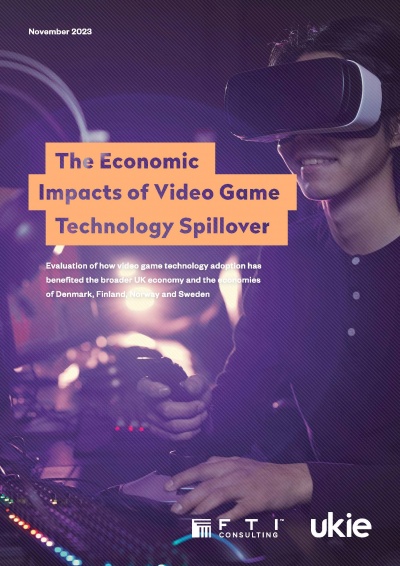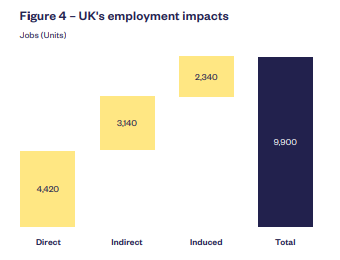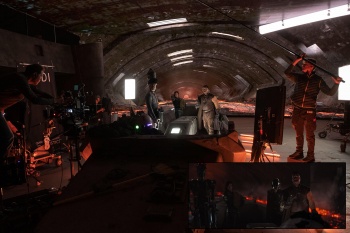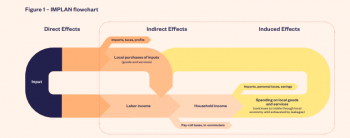Difference between revisions of "Video Game Technology Spillover"
(Created page with "thumb|border|400px|Ukie and FTI 2023 Economic Impacts of Video Game Technology Spillover report == The Economic Impacts of Video Game...") |
|||
| (6 intermediate revisions by the same user not shown) | |||
| Line 1: | Line 1: | ||
[[File:Game Spillover front cover.jpg|thumb|border|400px|Ukie and FTI 2023 Economic Impacts of Video Game Technology Spillover report]] | [[File:Game Spillover front cover.jpg|thumb|border|400px|Ukie and FTI 2023 Economic Impacts of Video Game Technology Spillover report]] | ||
| − | + | In 2023, Ukie and FTI Consulting [https://ukie.org.uk/news/2023/11/spillover-technology-from-video-games-worth-1-3-billion-in-2021 published a report] that assessed the impact of video game technologies’ contribution to non-game sectors in the UK and select Nordic economies. | |
| − | |||
| − | In 2023, Ukie and FTI Consulting | ||
The report defined ‘spillover’ technology as instances where otherwise unrelated sectors have adopted and applied innovations from game developers to enhance their products and improve their business operations. | The report defined ‘spillover’ technology as instances where otherwise unrelated sectors have adopted and applied innovations from game developers to enhance their products and improve their business operations. | ||
| − | ==Games Spillover in the United Kingdom== | + | == Games Spillover in the United Kingdom == |
| − | |||
| + | In 2021, the video game industry had a substantial impact on the UK economy, with technology spillovers extending far beyond the games sector. These spillovers influenced various industries, showcasing the widespread application of video game technologies such as game engines, virtual reality (VR), and augmented reality (AR). | ||
| − | + | The economic impact of these spillovers is measured in three key areas: '''direct''', '''indirect''', and '''induced''' effects. | |
| − | *''' | + | * '''Direct effects''' refer to the immediate economic contributions of video game technologies, such as the jobs created directly within the industry. |
| + | * '''Indirect effects''' encompass the economic activity generated within the supply chain due to the demand for goods and services needed by the video game sector. | ||
| + | * '''Induced effects''' are the broader economic impacts resulting from the increased household spending by those employed in both the direct and indirect sectors. | ||
| − | + | Together, these direct, indirect, and induced impacts significantly contributed to the UK's output and employment in 2021. | |
| − | + | == Key Figures == | |
| − | |||
| − | |||
| − | |||
| − | |||
| + | {| class="wikitable" | ||
| + | ! Metric !! Value | ||
| + | |- | ||
| + | | '''Employment''' || Nearly 10,000 jobs supported by video game technology spillovers in the UK. | ||
| + | |- | ||
| + | | '''Output''' || £1.3 billion in total economic output from these spillovers. | ||
| + | |- | ||
| + | | '''GDP Contribution''' || £760 million added to the UK's GDP. | ||
| + | |- | ||
| + | | '''Labour Income''' || £380 million generated in labour income. | ||
| + | |- | ||
| + | | '''Government Revenues''' || £250 million contributed to government revenues. | ||
| + | |} | ||
---- | ---- | ||
| − | |||
| − | + | ===Employment Impact=== | |
| − | + | Video game technology spillovers supported nearly 10,000 jobs across various sectors in the UK in 2021 in the following areas: | |
| − | = | + | {| class="wikitable" |
| − | + | |+ Employment Impact of Video Game Technology Spillovers in the UK (2021) | |
| − | + | |- | |
| − | + | ! Sector !! Jobs Supported | |
| − | + | |- | |
| + | | Information Technology || 3,000 | ||
| + | |- | ||
| + | | Business Services || 1,560 | ||
| + | |- | ||
| + | [[File:Game Spillover report - Employment Impact Breakdown.png|thumb|right|350px|breakdown of UK's Employment Impact]] | ||
| + | | Energy Extraction || 990 | ||
| + | |- | ||
| + | | Wholesale and Retail || 910 | ||
| + | |- | ||
| + | | Healthcare || 450 | ||
| + | |- | ||
| + | | Machinery Manufacturing || 420 | ||
| + | |- | ||
| + | | Fabricated Metals || 310 | ||
| + | |- | ||
| + | | Finance and Insurance || 290 | ||
| + | |- | ||
| + | | Arts and Entertainment || 280 | ||
| + | |- | ||
| + | | Publishing and Audiovisual || 280 | ||
| + | |} | ||
| − | ==== | + | == Comparative Salaries == |
| − | |||
| − | |||
| + | The average annual salary for workers directly employed as a result of video game technology spillovers was approximately '''£42,990'''. This is about 25% higher than the average annual salary of a UK worker, which stands at £34,280. | ||
| + | ==Games Spillover in Nordic Countries== | ||
| − | + | The report also looked at the impact of video games technology in Nordic Countries. These countries were Denmark, Finland, Norway, and Sweden | |
| − | |||
| − | |||
| − | |||
| + | ===Key Figures=== | ||
| + | * '''Employment''': Video game technology spillovers supported over 5,300 jobs across Denmark, Finland, Norway, and Sweden. | ||
| + | * '''Output''': The total economic output from these spillovers was approximately £1.3 billion. | ||
| + | * '''GDP Contribution''': The spillovers added around £890 million to the combined GDP of these countries. | ||
| + | * '''Labour Income''': The spillovers generated £260 million in labour income. | ||
| + | * '''Government Revenues''': The activities supported by these spillovers contributed £320 million to government revenues. | ||
| + | === Country-Specific Impact === | ||
| − | + | '''Denmark''' | |
| − | + | * '''Output''': £190 million | |
| − | * ''' | + | * '''GDP Contribution''': £120 million |
| + | * '''Employment''': 1,100 jobs | ||
| + | * '''Labour Income''': £50 million | ||
| + | * '''Government Revenues''': £40 million | ||
| + | '''Finland''' | ||
| + | * '''Output''': £130 million | ||
| + | * '''GDP Contribution''': £60 million | ||
| + | * '''Employment''': 890 jobs | ||
| + | * '''Labour Income''': £30 million | ||
| + | * '''Government Revenues''': £30 million | ||
| + | '''Norway''' | ||
| + | * '''Output''': £700 million | ||
| + | * '''GDP Contribution''': £570 million | ||
| + | * '''Employment''': 1,670 jobs | ||
| + | * '''Labour Income''': £100 million | ||
| + | * '''Government Revenues''': £180 million | ||
| − | + | '''Sweden''' | |
| − | + | * '''Output''': £270 million | |
| − | * ''' | + | * '''GDP Contribution''': £140 million |
| + | * '''Employment''': 1,710 jobs | ||
| + | * '''Labour Income''': £80 million | ||
| + | * '''Government Revenues''': £70 million | ||
| − | + | =Examples of Video Game Technology Spillovers= | |
| − | + | [[File:Unreal+Engine_blog_forging-new-paths-for-filmmakers-on-the-mandalorian_Mandalorian_HUC-027199.pip-1920x1280-fdd903d31d9223ddd9fef02820ccf60b7414852f.jpg|thumb|right|350px|The set of ''The Mandalorian''. Technology from video game engines such as Unreal was used to help develop the show]] | |
| − | |||
| − | |||
| − | |||
| − | |||
| − | |||
| − | |||
| − | |||
| − | |||
| − | |||
| − | |||
| − | |||
| − | |||
| − | |||
| − | |||
| − | |||
| − | |||
| − | |||
{| class="wikitable" | {| class="wikitable" | ||
| − | + | ! Sector !! Technology !! Description | |
|- | |- | ||
| − | + | | rowspan="4" | '''Healthcare''' || '''AR Applications''' || AR assists healthcare workers in locating veins and planning surgical procedures by overlaying digital images onto the real world, improving accuracy and efficiency. | |
|- | |- | ||
| − | | | + | | '''Haptic Technology''' || [https://fundamentalsurgery.com/platform/hapticvr/ FundamentalVR’s HapticVR] technology provides life-like surgical training using haptic gloves and controllers. This platform has been deployed by institutions like St. George’s Hospital and the Houston Methodist Institute, offering a realistic training environment for medical professionals. |
|- | |- | ||
| − | | | + | | '''Patient Care''' || VR technologies like [https://www.relievrx.com/ RelieVRx], developed by AppliedVR, aid in chronic pain management by employing cognitive behavioural therapy principles, significantly reducing pain for users in clinical trials. |
|- | |- | ||
| − | | | + | | '''Pharmaceutical Development''' || [https://c4xdiscovery.com/our-approach/#:~:text=4sight,medical%20industry%E2%80%99s%20needs. 4Sight by C4X Discovery] uses Unreal Engine to visualise molecular data in a VR space, aiding in drug discovery and development. This technology enhances scientists' ability to interact with complex data and has been instrumental in projects like the development of a COVID-19 vaccine. |
|- | |- | ||
| − | | Wholesale and Retail || | + | | rowspan="1" | '''Wholesale and Retail''' || '''"Try-Before-You-Buy"''' || AR applications allow customers to virtually try products before purchasing, improving customer satisfaction and engagement. This technology enables users to visualise how products like furniture or clothing will look in their homes or on them before making a purchase. |
|- | |- | ||
| − | | | + | | rowspan="2" | '''Machinery Manufacturing''' || '''Digital Designs and Simulations''' || Tools like [https://unity.com/resources/unity-for-artengine Unity’s ArtEngine] enable manufacturers to create detailed digital twins of products, providing a virtual representation of a physical object. For example, [https://store.flokk.com/uk/en-gb/products Flokk] uses these digital twins to offer customers a realistic visualisation of customisable chair components, improving the online shopping experience and reducing returns. |
|- | |- | ||
| − | | | + | | '''Interactive Product Visualisation''' || Companies like [https://unity.com/case-study/autoliv Autoliv] use game engines to create interactive 3D views of automotive safety parts, allowing customers to explore products in detail from multiple angles. |
|- | |- | ||
| − | | | + | | rowspan="2" | '''Publishing and Audiovisual''' || '''Visual Effects''' || Game engines are instrumental in enhancing the production of visual effects (VFX) for television and film. For example, the cinematographer of Disney+’s ''The Mandalorian'' praised game engines for their ability to speed up the production process and improve the final product. By providing real-time views of the finished VFX, these engines reduce the need for physical props and on-location shooting, enabling more sustainable and cost-effective productions. |
|- | |- | ||
| − | | | + | | '''Virtual Production''' || Virtual production refers to the use of game engines to create dynamic, photo-real digital landscapes that can be displayed in real-time during filming. This technology allows filmmakers to see and interact with visual effects directly in-camera, rather than adding them in post-production. Studios like [https://www.ilm.com/ilmxlab-epic-games-team-showcase-vr-visual-development/ Industrial Light & Magic] and [https://www.screendaily.com/news/film-soho-to-launch-virtual-production-studio-in-central-london-exclusive/5170458.article Film Soho] are leading the way in this field, using game engines to enhance the production of films and TV shows such as "Thor: Love and Thunder" and "Rogue One: A Star Wars Story". |
|- | |- | ||
| − | | | + | | rowspan="2" | '''Aerospace and Marine''' || '''VR Training''' || Companies like [https://youtu.be/B3p_SEJwhJ4?si=F4waOLY3rbgGTXmk Neptune Energy] use VR applications for offshore worker training, allowing them to interact with realistic 3D models of platforms from onshore. This reduces the need for travel, lowers costs, and enhances safety. |
|- | |- | ||
| − | | | + | | '''Digital Twins''' || [https://www.equinor.com/energy/digital-twin Equinor] employs digital twin solutions to navigate installations and collaborate in real-time, improving project development and operational efficiency. By using these digital replicas, Equinor can better manage complex projects, predict potential issues, and streamline operations across their installations. |
|} | |} | ||
| + | |||
| + | =Methodology= | ||
| + | The analysis was conducted using the IMPLAN model, an input-output (IO) model that provides a detailed understanding of how changes in one part of the economy affect the broader economic landscape. | ||
| + | |||
| + | FTI Consulting used the IMPLAN model to measure five key economic metrics across the UK, Denmark, Finland, Norway, and Sweden: | ||
| + | |||
| + | * '''Employment''': The number of jobs supported by video game technology spillovers. | ||
| + | * '''Output''': The total revenue generated by businesses associated with video game technology. | ||
| + | * '''GDP''': The total income related to production activities supported by video game technology. | ||
| + | * '''Labour Income''': The household income generated through employment in sectors impacted by video game technology. | ||
| + | * '''Government Revenues''': The tax revenues generated for all levels of government due to increased economic activity driven by video game technology spillovers. | ||
| + | |||
| + | [[File:Screenshot 2024-08-14 180439.png|thumb|right|350px|The IMPLAN flowchart used to calculate the spillover of video game technology]] | ||
| + | |||
| + | The IMPLAN model tracks the direct impacts of video game technology—such as jobs and revenues within the industry—and also accounts for indirect and induced effects. Indirect effects include the economic activities in the supply chain triggered by the industry, while induced effects capture the broader economic activities supported by the wages of employees in both the direct and indirect sectors. | ||
| + | |||
| + | To adapt the IMPLAN model for the UK and Nordic economies, FTI Consulting used detailed data from the US as a proxy, mapping these results onto European countries using the European IMPLAN models. This approach ensured that the spillover effects of video game technology were accurately reflected in the economic analyses. | ||
Latest revision as of 17:08, 14 August 2024
In 2023, Ukie and FTI Consulting published a report that assessed the impact of video game technologies’ contribution to non-game sectors in the UK and select Nordic economies.
The report defined ‘spillover’ technology as instances where otherwise unrelated sectors have adopted and applied innovations from game developers to enhance their products and improve their business operations.
Contents
Games Spillover in the United Kingdom
In 2021, the video game industry had a substantial impact on the UK economy, with technology spillovers extending far beyond the games sector. These spillovers influenced various industries, showcasing the widespread application of video game technologies such as game engines, virtual reality (VR), and augmented reality (AR).
The economic impact of these spillovers is measured in three key areas: direct, indirect, and induced effects.
- Direct effects refer to the immediate economic contributions of video game technologies, such as the jobs created directly within the industry.
- Indirect effects encompass the economic activity generated within the supply chain due to the demand for goods and services needed by the video game sector.
- Induced effects are the broader economic impacts resulting from the increased household spending by those employed in both the direct and indirect sectors.
Together, these direct, indirect, and induced impacts significantly contributed to the UK's output and employment in 2021.
Key Figures
| Metric | Value |
|---|---|
| Employment | Nearly 10,000 jobs supported by video game technology spillovers in the UK. |
| Output | £1.3 billion in total economic output from these spillovers. |
| GDP Contribution | £760 million added to the UK's GDP. |
| Labour Income | £380 million generated in labour income. |
| Government Revenues | £250 million contributed to government revenues. |
Employment Impact
Video game technology spillovers supported nearly 10,000 jobs across various sectors in the UK in 2021 in the following areas:
| Sector | Jobs Supported |
|---|---|
| Information Technology | 3,000 |
| Business Services | 1,560 |
| Energy Extraction | 990 |
| Wholesale and Retail | 910 |
| Healthcare | 450 |
| Machinery Manufacturing | 420 |
| Fabricated Metals | 310 |
| Finance and Insurance | 290 |
| Arts and Entertainment | 280 |
| Publishing and Audiovisual | 280 |
Comparative Salaries
The average annual salary for workers directly employed as a result of video game technology spillovers was approximately £42,990. This is about 25% higher than the average annual salary of a UK worker, which stands at £34,280.
Games Spillover in Nordic Countries
The report also looked at the impact of video games technology in Nordic Countries. These countries were Denmark, Finland, Norway, and Sweden
Key Figures
- Employment: Video game technology spillovers supported over 5,300 jobs across Denmark, Finland, Norway, and Sweden.
- Output: The total economic output from these spillovers was approximately £1.3 billion.
- GDP Contribution: The spillovers added around £890 million to the combined GDP of these countries.
- Labour Income: The spillovers generated £260 million in labour income.
- Government Revenues: The activities supported by these spillovers contributed £320 million to government revenues.
Country-Specific Impact
Denmark
- Output: £190 million
- GDP Contribution: £120 million
- Employment: 1,100 jobs
- Labour Income: £50 million
- Government Revenues: £40 million
Finland
- Output: £130 million
- GDP Contribution: £60 million
- Employment: 890 jobs
- Labour Income: £30 million
- Government Revenues: £30 million
Norway
- Output: £700 million
- GDP Contribution: £570 million
- Employment: 1,670 jobs
- Labour Income: £100 million
- Government Revenues: £180 million
Sweden
- Output: £270 million
- GDP Contribution: £140 million
- Employment: 1,710 jobs
- Labour Income: £80 million
- Government Revenues: £70 million
Examples of Video Game Technology Spillovers
| Sector | Technology | Description |
|---|---|---|
| Healthcare | AR Applications | AR assists healthcare workers in locating veins and planning surgical procedures by overlaying digital images onto the real world, improving accuracy and efficiency. |
| Haptic Technology | FundamentalVR’s HapticVR technology provides life-like surgical training using haptic gloves and controllers. This platform has been deployed by institutions like St. George’s Hospital and the Houston Methodist Institute, offering a realistic training environment for medical professionals. | |
| Patient Care | VR technologies like RelieVRx, developed by AppliedVR, aid in chronic pain management by employing cognitive behavioural therapy principles, significantly reducing pain for users in clinical trials. | |
| Pharmaceutical Development | 4Sight by C4X Discovery uses Unreal Engine to visualise molecular data in a VR space, aiding in drug discovery and development. This technology enhances scientists' ability to interact with complex data and has been instrumental in projects like the development of a COVID-19 vaccine. | |
| Wholesale and Retail | "Try-Before-You-Buy" | AR applications allow customers to virtually try products before purchasing, improving customer satisfaction and engagement. This technology enables users to visualise how products like furniture or clothing will look in their homes or on them before making a purchase. |
| Machinery Manufacturing | Digital Designs and Simulations | Tools like Unity’s ArtEngine enable manufacturers to create detailed digital twins of products, providing a virtual representation of a physical object. For example, Flokk uses these digital twins to offer customers a realistic visualisation of customisable chair components, improving the online shopping experience and reducing returns. |
| Interactive Product Visualisation | Companies like Autoliv use game engines to create interactive 3D views of automotive safety parts, allowing customers to explore products in detail from multiple angles. | |
| Publishing and Audiovisual | Visual Effects | Game engines are instrumental in enhancing the production of visual effects (VFX) for television and film. For example, the cinematographer of Disney+’s The Mandalorian praised game engines for their ability to speed up the production process and improve the final product. By providing real-time views of the finished VFX, these engines reduce the need for physical props and on-location shooting, enabling more sustainable and cost-effective productions. |
| Virtual Production | Virtual production refers to the use of game engines to create dynamic, photo-real digital landscapes that can be displayed in real-time during filming. This technology allows filmmakers to see and interact with visual effects directly in-camera, rather than adding them in post-production. Studios like Industrial Light & Magic and Film Soho are leading the way in this field, using game engines to enhance the production of films and TV shows such as "Thor: Love and Thunder" and "Rogue One: A Star Wars Story". | |
| Aerospace and Marine | VR Training | Companies like Neptune Energy use VR applications for offshore worker training, allowing them to interact with realistic 3D models of platforms from onshore. This reduces the need for travel, lowers costs, and enhances safety. |
| Digital Twins | Equinor employs digital twin solutions to navigate installations and collaborate in real-time, improving project development and operational efficiency. By using these digital replicas, Equinor can better manage complex projects, predict potential issues, and streamline operations across their installations. |
Methodology
The analysis was conducted using the IMPLAN model, an input-output (IO) model that provides a detailed understanding of how changes in one part of the economy affect the broader economic landscape.
FTI Consulting used the IMPLAN model to measure five key economic metrics across the UK, Denmark, Finland, Norway, and Sweden:
- Employment: The number of jobs supported by video game technology spillovers.
- Output: The total revenue generated by businesses associated with video game technology.
- GDP: The total income related to production activities supported by video game technology.
- Labour Income: The household income generated through employment in sectors impacted by video game technology.
- Government Revenues: The tax revenues generated for all levels of government due to increased economic activity driven by video game technology spillovers.
The IMPLAN model tracks the direct impacts of video game technology—such as jobs and revenues within the industry—and also accounts for indirect and induced effects. Indirect effects include the economic activities in the supply chain triggered by the industry, while induced effects capture the broader economic activities supported by the wages of employees in both the direct and indirect sectors.
To adapt the IMPLAN model for the UK and Nordic economies, FTI Consulting used detailed data from the US as a proxy, mapping these results onto European countries using the European IMPLAN models. This approach ensured that the spillover effects of video game technology were accurately reflected in the economic analyses.



